

The language of heraldry
by Mike Oettle
IT has been said that Old French is the language of heraldry, and certainly if you look at English books on the subject you might think that this is true. It is full of obscure and arcane terminology that makes little or no sense to the ordinary reader.
However, as you learn more about the subject you find that heraldry has a language of its own which, once learned, describes concisely how a particular coat of arms is put together.
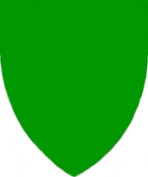
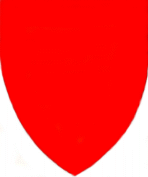
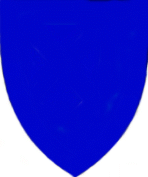
This is not to say that this language cannot be simplified. Especially when it comes to colour, it is perfectly permissible to say that a shield is blue, or red, or green, rather than azure, gules or vert. (See here for a discussion of the colours of heraldry.)
But many of the technical terms used in heraldry have no simple everyday equivalent, and a tedious and verbose description is required to avoid their use.
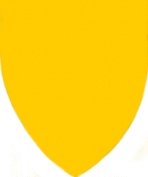
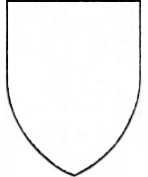
Even the names of the metals, or and argent, present problems. For while they can be called gold and silver, using these words can be misinterpreted, since both the metals have traditionally appeared in two different forms: when represented in cloth, or has always been yellow, not metallic gold, and argent white, rather than anything silvery. (See here for the metals of heraldry.)
The same problem arises with the terms dexter and sinister, which in Afrikaans are simply regs and links. While it is necessary to explain to a person unfamiliar with heraldry what dexter and sinister are, their meaning is quickly learned. But it needs to be explained over and over to the Afrikaans-speaker without knowledge of heraldry that heraldic regs is left as seen by the viewer and links is right, whereas these distinctions are inherent in the use of the terms dexter and sinister – they are clearly heraldic usage, and cannot be confused with ordinary left and right.
Many of heraldry’s technical terms have indeed been taken into English from Old French. Yet the language of blazon in Britain, in America and in South Africa (when it is not Afrikaans or, in older examples, Dutch), as technical and obscure as it often can be, is nonetheless English – albeit a special English jargon. Aside from its French-derived words and its unusual word order, it is certainly English, as becomes very clear when the same blazon is read side by side in French and in English.
Its verbs behave like English verbs, its nouns have English plurals, and its adjectives and adverbs likewise are English.
This becomes even clearer when blazons are read in other languages besides French, since the terminology in each language of Europe is the language of the country, with or without loanwords.
What makes French blazon especially obscure is its use of abbreviations and small roman numerals – this usage is especially frustrating to the reader of J B Rietstap’s Armorial Général. As concise as Rietstap’s blazons are, they require special concentration to decipher.
Afrikaans is an example of a language without much in the way of obscure verbiage when it comes to heraldry, yet even here there are certain conventions that must be followed, certain technical terms that must be used, without which heraldic blazon loses its precision.
Certainly in the past heralds often went out of their way to make blazon complex. This has been put down in part to the fact that in the late Middle Ages, heraldry was taught at the universities in the faculties of law, and lawyers have a tendency to use obscure language.
The Heraldry Act of 1962 had the outcome of putting heraldic language in both English and Afrikaans under official auspices.
Before that year heraldry, on an official level, existed in two forms:
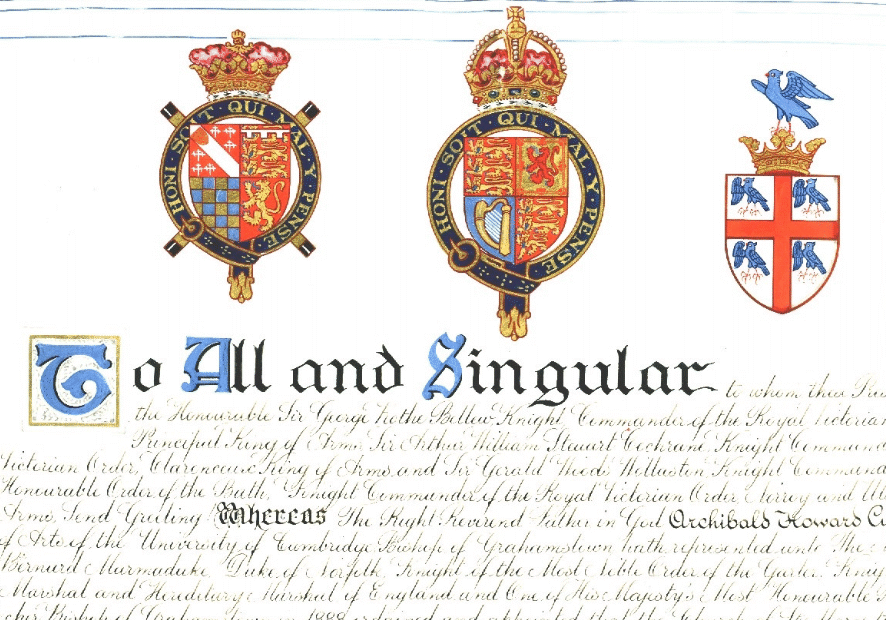
Firstly, municipalities and private individuals would, at times, apply to the College of Arms in London for a grant of arms.
The heralds applied the laws of heraldry strictly, and if they found the device acceptable, it would be blazoned (described) on an official document (on parchment) in an almost mediæval style of English, and illustrated.
These grants of heraldic emblems was carried out in terms of English law (in exceptional cases under Scottish or Irish law, through the heralds in Edinburgh or in Dublin)[1] and under royal authority. The government of the Union of South Africa had no part in this at all.
Otherwise, it was possible in terms of the Union Parliament’s Protection of Names, Uniforms and Badges Act (1935) to apply for the registration of a “badge” (the word here not being used in its heraldic sense). There was no expert help available in this instance, as with the British heralds, and no attempt was made to register devices drawn up according to established norms.
Even the definition of such “badges” was non-heraldic. Any drawing submitted by the applicant was merely accepted as a correct rendition.
The possibility for abuse can be illustrated with the story of the arms of the South African College (now the University of Cape Town and the South African College School [SACS]). The arms were devised – in accordance with heraldic norms – in 1849 by Charles Davidson Bell (designer of the Cape triangular stamp) which was submitted for registration by the university.
However, Bell’s crest of Table Mountain proved problematic, because it was too broad to fit on a helmet (he had not drawn one). The registration document was issued including this irregular crest (sitting flat on the top of the shield), and for decades UCT used its arms in this form, mountain and all.
Only in the 1960s, following the implementation of the Heraldry Act, was the matter gone into again, and the mountain was removed from the university’s arms.
However, SACS (by this time split as the SA College Schools, a high school and a primary school) continued using the mountain on its badge, and does so to this day.
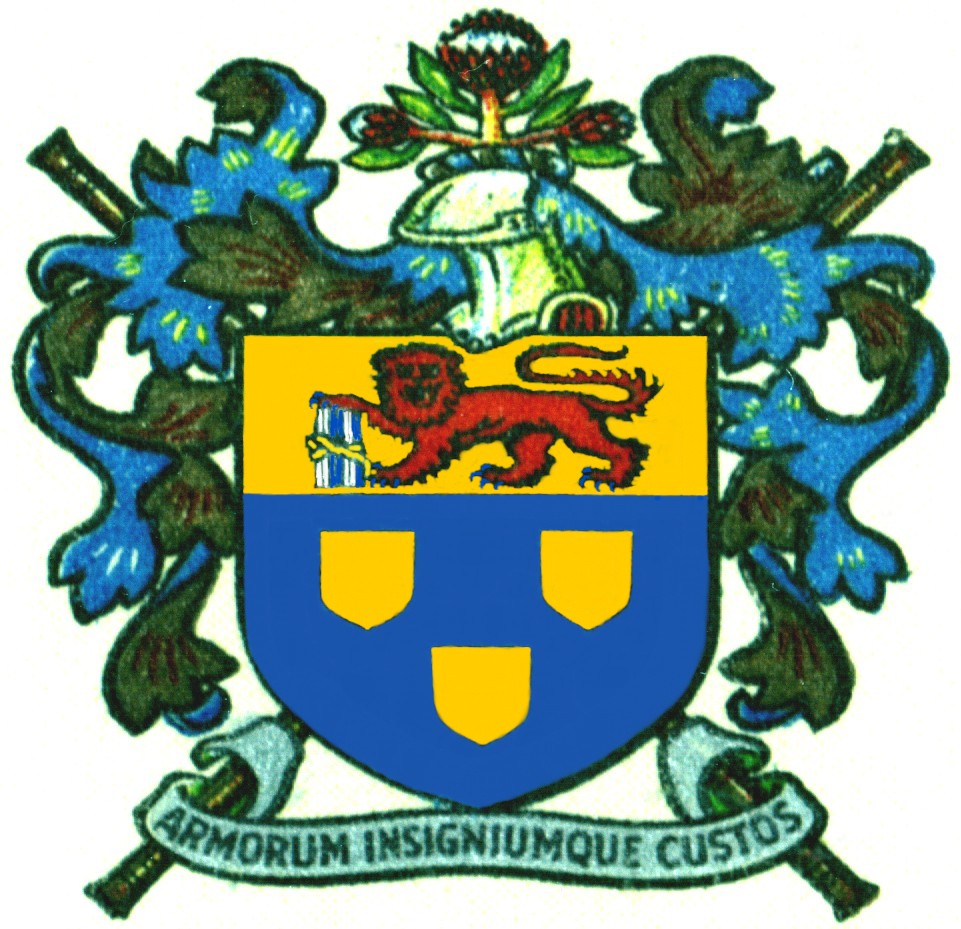
The appointment of the first State Herald in 1963 then meant that it was for the first time possible to see heraldry function on an official level in South Africa. Certificates were issued by the Bureau of Heraldry in either English or Afrikaans, or sometimes in both languages.
But of course heraldry in South Africa does not stem solely from Britain or the Netherlands. The families making up the Afrikaans- and English-speaking communities of this country spring from several European countries.
Even if only 20% of those families bear arms, this involves the heraldic traditions of Germany, Switzerland, France, Belgium, Wales, Scotland, Ireland, Denmark, Sweden, Italy and even Portugal. South African families also originate from other European countries, and each has its own heraldic traditions and heraldic language.
Some Afrikaner families can also trace their ancestry to countries in Asia and in Africa, countries lacking a heraldic tradition. In most cases it involves descent in the female line, where heraldry is not usually relevant. There is, however, one Afrikaner family which has traditionally been traced back to a male Oriental.
I refer to the Snyman family, whose family tree goes back to a Bengali, the freedman (former slave) Anthonij van Bengale. But in fact Anthonij was the stepfather of Christoffel Snyman, the child of his wife, who was also of Indian origin. Christoffel was married to the Hugenot Marguerite (or Margo) de Savoye. (See below for further details.)

The Snymans have a coat of arms in the Dutch tradition which has been registered by one member of the family, which means that other members of the family can also register it. To see this device, click here.
I mention this instance to indicate that, when speaking of heraldic tradition, it is not unfair to leave families of non-European origin out of reckoning, because these countries do not have deeply rooted heraldic traditions.
But on the other hand it cannot be said that heraldry does not exist in these countries, or that South Africans who are not of European origin, are not entitled to bear heraldic arms.
The British heralds granted arms to various former colonies in Africa and Asia which are now independent states, and to cities and other instititutions in those countries, as well as personal arms to citizens of such countries.
And in South Africa the Heraldry Act confirms the right of all citizens to register arms. The majority of black an brown South Africans might feel it unnecessary to register arms, but it is their right should they so wish.
Similarly, many white South Africans may feel it unnecessary to register arms, but any citizen may do so – either with an existing family coat of arms (suitably differenced) or with a completely new device for a family which does not already bear arms.
